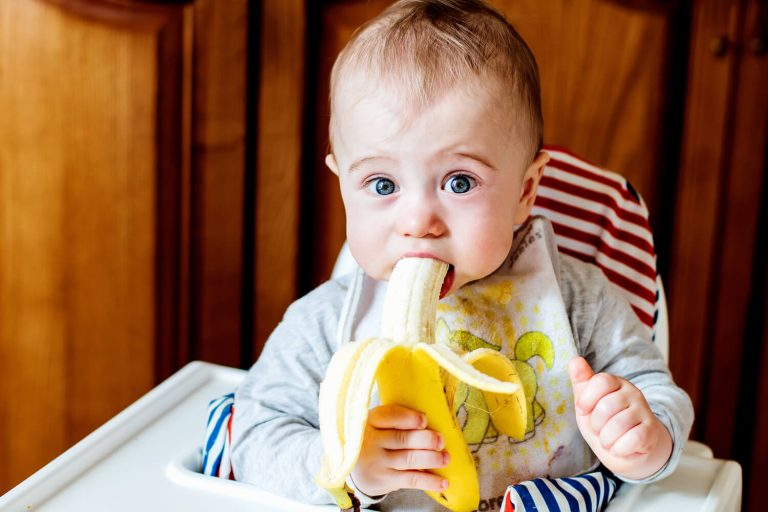Introducing Solids: Baby-Led Weaning vs. Traditional Methods

When it comes to introducing your baby to the world of solid foods, you have choices to make. But before discussing those options, let’s first understand what weaning means.
What is Weaning:
When a baby starts eating solid foods instead of just drinking milk, it’s called weaning. It’s a gradual process of introducing new foods and helping the baby learn to eat different types of food. It is an important step in their growth and development.
The process of weaning may vary based on factors such as the age and readiness of the baby, cultural practices, and individual preferences.
Types of weaning
There are two basic types of weaning:
- Baby-Led Weaning
- Traditional Weaning (Spoon-Feeding Weaning)
Baby-Led Weaning (BLW)

Baby-Led Weaning (BLW) is an approach to introducing solid foods where babies feed themselves instead of being spoon-fed. They are given soft foods they can grab and eat on their own. It allows babies to explore different tastes and textures, develop their motor skills, and control how much they eat.
The Best First Foods for BL Weaning:
- Roasted sweet potato wedges
- Roasted apple wedges, skin on, to help them hold together.
- Roasted or steamed broccoli florets (big enough for a baby to hold)
- Melon slices.
- Thick mango slice.
- Banana with some of the peel still on.
Pros and Cons of baby-led weaning
Here are some pros and cons of Baby-Led Weaning (BLW) to help you decide if it’s the right fit for you and your baby.
Pros of Baby-Led Weaning
- Self-feeding skills:
Babies learn to feed themselves and develop fine motor skills. - Exploration of tastes:
They can try different textures and flavors, expanding their food preferences. - Independence:
It encourages independence and allows babies to decide when they are full. - Family mealtime:
Including babies in family meals promotes bonding and healthy eating habits. - Parental enjoyment:
Caregivers can have their meals while the baby feeds independently.
Cons of Baby-Led Weaning
- Choking risk:
There is a high risk of babies choking on certain foods. - Limited food intake:
Baby may choose certain foods initially, which could be a concern for getting enough nutrition. - Nutritional Imbalance:
Babies may choose certain foods over others, leading to imbalances in nutrients. - Messy and wasted food:
It can be messy, and babies may waste food by playing with it. - More time-consuming:
It takes more time.
Traditional Weaning:

Traditional Weaning, also known as spoon-feeding weaning, is an approach to introducing solid foods to babies in which caregivers actually feed the baby with a spoon. It involves offering pureed or mashed food to the baby, typically starting with single-ingredient purees and gradually progressing to more complex food combinations.
Why is spoon-feeding important?
- Feeding with a spoon is beneficial for eye-hand coordination.
- Developing a grasping pattern
- Improving posture.
- Strengthening important muscles in the upper body.
- Promoting independence through eating
- It is a great sensory integration activity.
Pros and Cons of Traditional Weaning
Here are some pros and cons of Baby-Led Weaning (BLW) to help you decide if it’s the right fit for you and your baby.
Pros of Traditional Weaning
- Controlled introduction
Caregivers can choose and introduce different foods gradually. - Nutrition:
It ensures the baby receives the necessary nutrients for their growth. - Safety:
Spoon-feeding reduces the risk of choking compared to finger foods. - Flexibility:
Foods can be customized based on the baby’s needs and preferences. - Less messy and wasted food:
It can be less messy, and less food is wasted as compared to finger food.
Cons Of Traditional Weaning
- Limited independence:
Babies have less chance to feed themselves and develop independence. - Picky eating:
It may increase the risk of picky eating habits and limited exposure to different food textures and flavors. - Mealtime challenges:
Spoon-feeding can be difficult and time-consuming. - Potential overfeeding:
Caregivers may accidentally give too much food, leading to difficulties with portion control. - Limited texture exploration:
Babies may not experience a wide variety of food textures with spoon-feeding.
Ending Note:
Remember that it’s not just about food, no matter how you decide to wean your baby. It’s a time to create special memories, encourage independence, and foster a love for healthy eating. Enjoy every moment as your little one explores the world of solids. Cheers to your parenting journey!
Do you have any questions or concerns? Do you have some feedback to share? Please feel free to reach out via the contact form.






